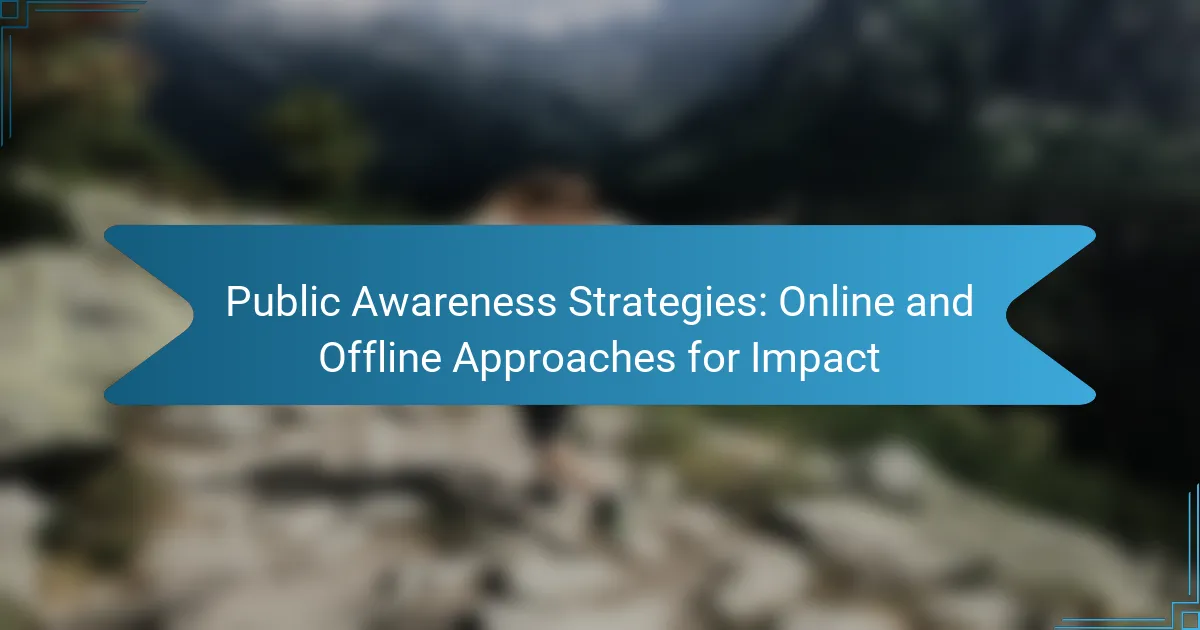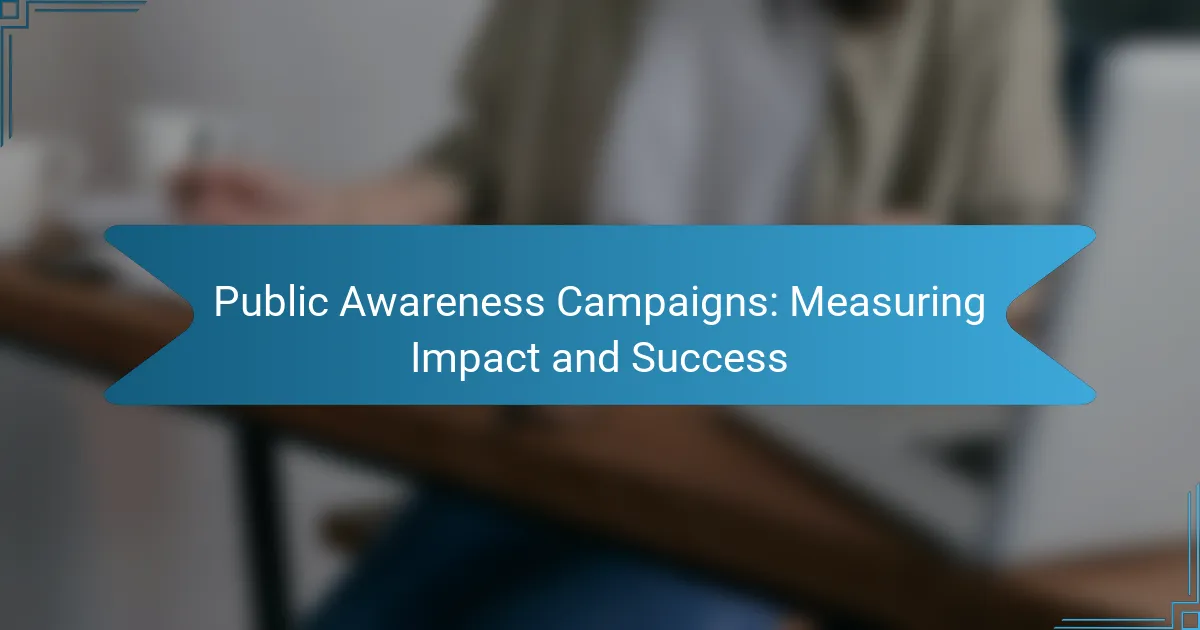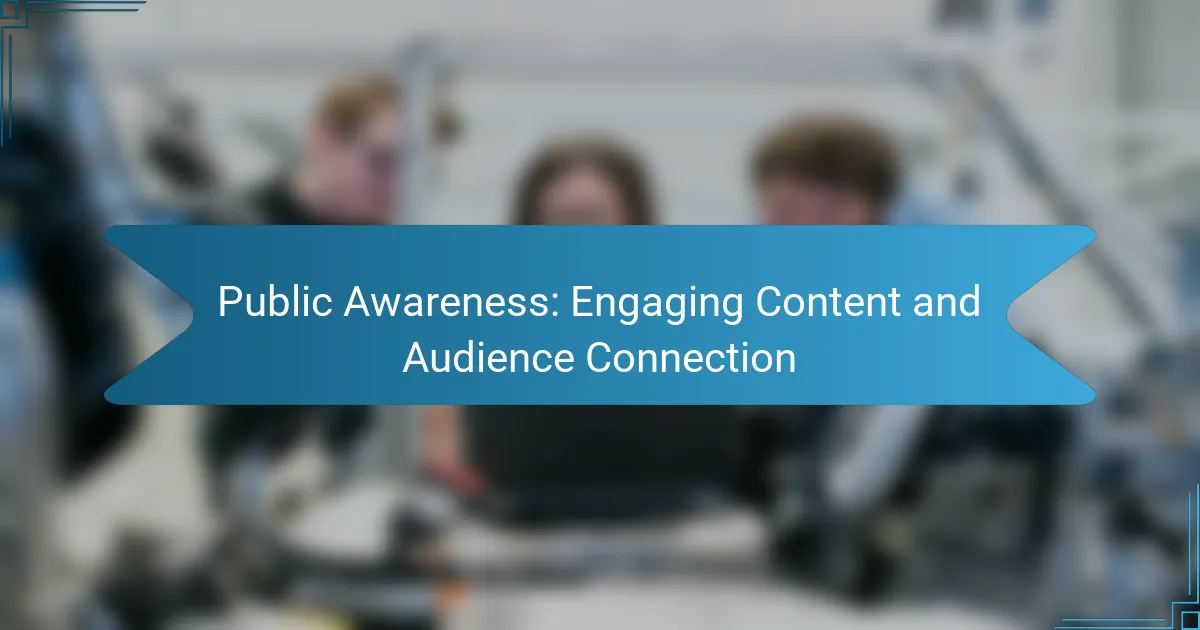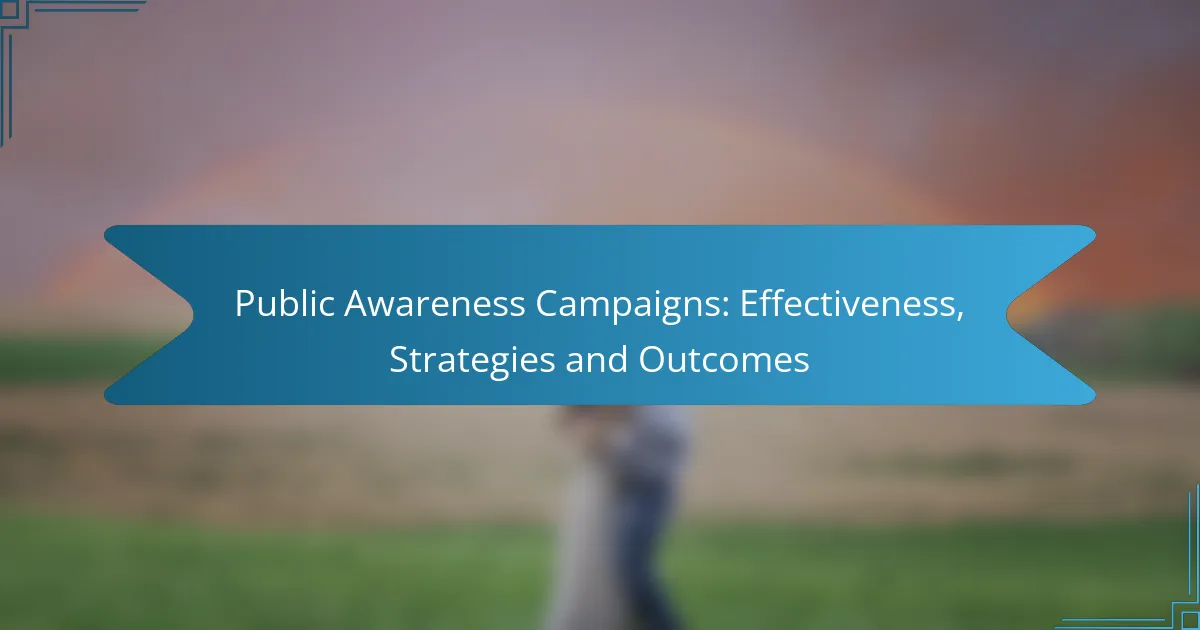Public awareness strategies play a crucial role in engaging communities and driving action, utilizing both online and offline approaches. Online methods harness digital platforms for broad outreach and interactive content, while offline strategies focus on personal connections and direct community engagement. Together, these approaches enhance visibility and foster meaningful interactions, ultimately measuring their effectiveness through audience feedback and engagement metrics.

What Are Effective Online Public Awareness Strategies?
Effective online public awareness strategies leverage digital platforms to engage audiences, disseminate information, and drive action. These strategies can enhance visibility and foster community involvement through targeted communication and interactive content.
Social Media Campaigns
Social media campaigns utilize platforms like Facebook, Twitter, and Instagram to reach diverse audiences. They can include paid advertisements or organic posts that encourage sharing and engagement, making them a cost-effective way to raise awareness.
To maximize impact, focus on creating visually appealing content and use hashtags to increase discoverability. Regularly monitor engagement metrics to refine your approach and ensure your message resonates with your audience.
Email Marketing
Email marketing remains a powerful tool for public awareness, allowing direct communication with subscribers. Crafting compelling subject lines and personalized content can significantly improve open and click-through rates.
Consider segmenting your email list based on interests or demographics to tailor messages effectively. Aim for a consistent schedule, but avoid overwhelming recipients with too many emails, which can lead to unsubscribes.
Content Marketing
Content marketing involves creating valuable information that educates and informs your audience. This can include blog posts, infographics, and videos that highlight key issues and promote your cause.
To be effective, ensure your content is relevant and shareable. Incorporate storytelling elements to connect emotionally with your audience, and optimize for search engines to increase visibility.
Search Engine Optimization
Search engine optimization (SEO) enhances the visibility of your online content in search engine results. By using relevant keywords, optimizing meta tags, and improving site speed, you can attract more visitors to your website.
Regularly updating your content and building backlinks from reputable sites can also boost your SEO efforts. Consider using tools like Google Analytics to track performance and adjust your strategy accordingly.
Webinars and Virtual Events
Webinars and virtual events provide interactive platforms for engaging audiences and sharing knowledge. These formats allow for real-time interaction, enabling participants to ask questions and discuss topics in depth.
To ensure success, promote your event across multiple channels and provide clear registration instructions. Follow up with attendees afterward to maintain engagement and gather feedback for future events.
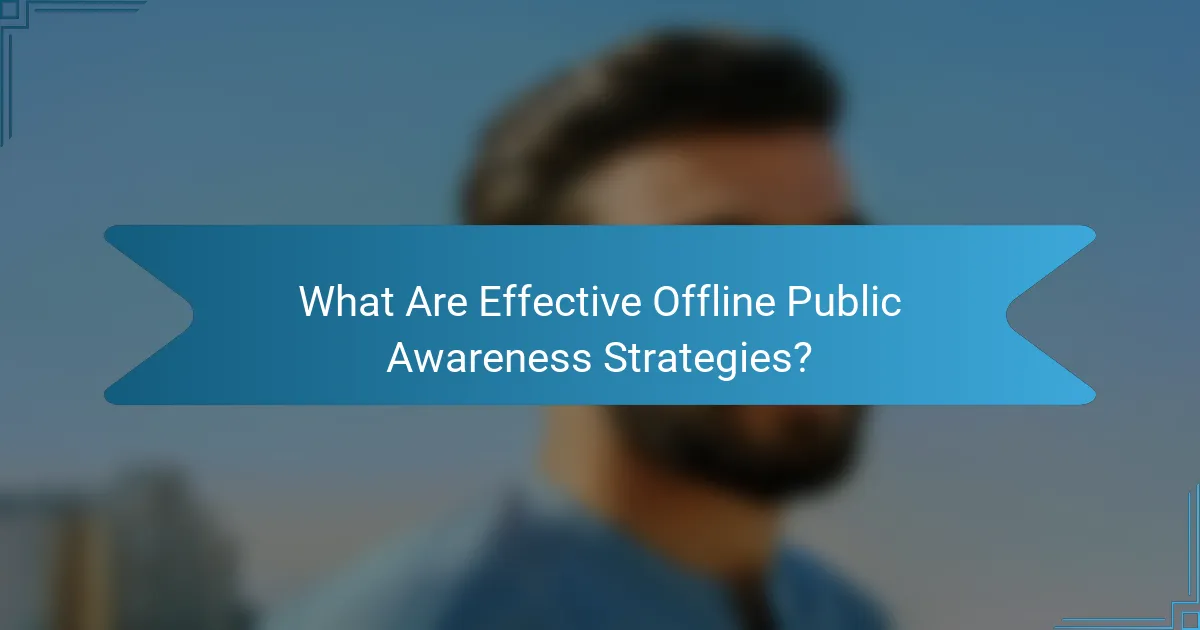
What Are Effective Offline Public Awareness Strategies?
Effective offline public awareness strategies involve direct engagement with the community through various methods that foster personal connections and convey messages clearly. These strategies can significantly enhance visibility and impact by utilizing local resources and personal interactions.
Community Events
Community events are gatherings that bring people together for a common purpose, such as fairs, festivals, or workshops. These events provide an opportunity to engage directly with the public, share information, and build relationships. Consider hosting informational booths, interactive activities, or demonstrations to attract attention and encourage participation.
When planning a community event, choose a location that is easily accessible and relevant to your target audience. Collaborating with local organizations can also enhance credibility and expand reach.
Print Advertising
Print advertising includes materials such as flyers, brochures, posters, and newspapers that communicate messages to the public. This traditional method can effectively reach audiences who may not engage with digital platforms. Ensure that your print materials are visually appealing and convey clear, concise information.
Consider distributing print materials in high-traffic areas, such as community centers, libraries, or local businesses. Using local newspapers for ads can also help target specific demographics and increase awareness within the community.
Public Speaking Engagements
Public speaking engagements involve presenting information to an audience, which can be a powerful way to raise awareness. These can take place at schools, community meetings, or conferences. Prepare engaging presentations that highlight key messages and encourage audience interaction.
To maximize impact, tailor your content to the interests and needs of your audience. Practice your delivery to ensure clarity and confidence, and be prepared to answer questions to foster deeper understanding.
Direct Mail Campaigns
Direct mail campaigns involve sending physical materials, such as postcards or newsletters, to targeted households. This method allows for personalized communication and can effectively reach specific demographics. Ensure your messaging is clear and includes a call to action to encourage responses.
When planning a direct mail campaign, segment your audience based on relevant criteria, such as location or interests. Tracking responses can help evaluate the effectiveness of your campaign and inform future strategies.
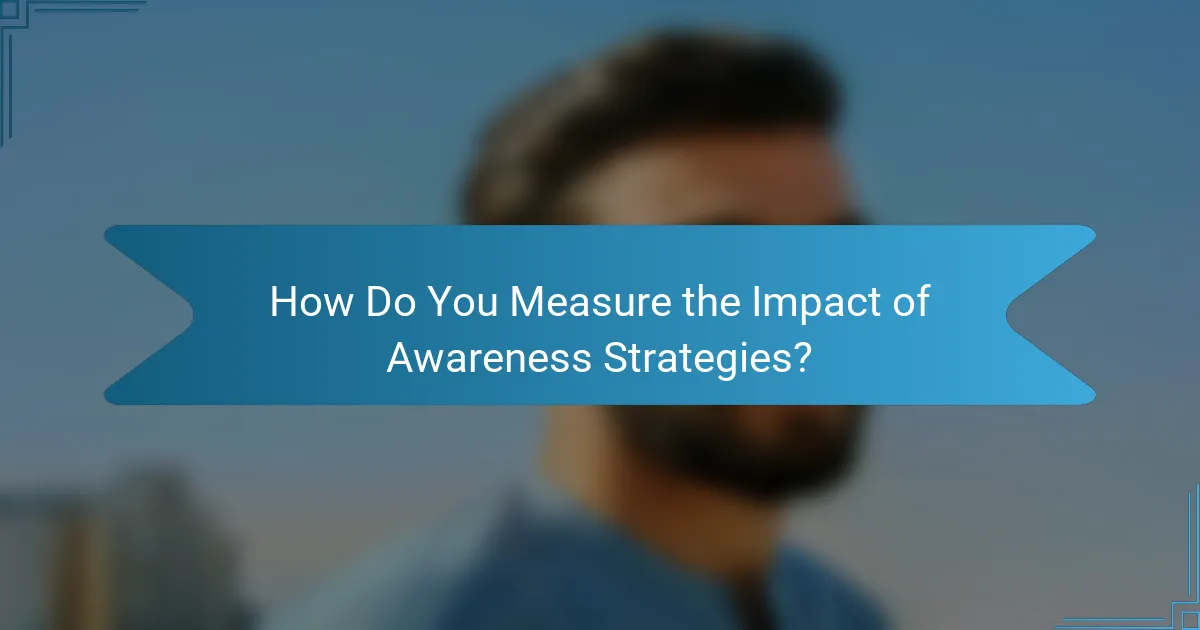
How Do You Measure the Impact of Awareness Strategies?
Measuring the impact of awareness strategies involves evaluating how effectively these initiatives reach and influence the target audience. Key metrics include direct feedback, engagement levels, and analytical data from various platforms.
Surveys and Feedback
Surveys are a direct way to gauge the effectiveness of awareness strategies. They can be distributed online or offline, allowing you to collect qualitative and quantitative data from your audience. Consider using a mix of closed and open-ended questions to capture a range of insights.
When designing surveys, aim for a completion time of under 5 minutes to encourage participation. Offering incentives, such as discounts or entries into a raffle, can also boost response rates.
Website Analytics
Website analytics provide valuable data on how users interact with your content. Tools like Google Analytics can track metrics such as page views, time spent on site, and bounce rates, helping you understand which awareness strategies drive traffic and engagement.
Focus on key performance indicators (KPIs) such as conversion rates and user behavior flows. Regularly reviewing this data can help you adjust your strategies based on what resonates most with your audience.
Social Media Engagement Metrics
Social media engagement metrics are crucial for assessing the reach and impact of your awareness strategies on platforms like Facebook, Twitter, and Instagram. Key metrics include likes, shares, comments, and follower growth, which indicate how well your content is resonating with users.
To effectively measure engagement, set specific goals for each campaign, such as increasing shares by a certain percentage. Regularly analyze these metrics to refine your approach and enhance future campaigns.

What Are the Key Criteria for Choosing Strategies?
Choosing effective public awareness strategies involves understanding your target audience, budget constraints, and available resources. These criteria help ensure that the strategies you implement will resonate with your audience and achieve the desired impact.
Target Audience Identification
Identifying your target audience is crucial for tailoring your public awareness strategies. Consider demographics such as age, gender, location, and interests to create messages that resonate. Conduct surveys or focus groups to gather insights about their preferences and behaviors.
Once you have a clear picture of your audience, segment them into groups based on shared characteristics. This allows for more personalized communication, which can significantly enhance engagement and effectiveness. For example, a campaign aimed at young adults may utilize social media platforms, while one targeting seniors might focus on community events.
Budget Considerations
Budget considerations play a vital role in determining which public awareness strategies are feasible. Establish a clear budget that outlines how much you can allocate to various activities, including advertising, materials, and events. This helps prioritize initiatives that will deliver the best return on investment.
When planning your budget, consider both direct costs and indirect expenses. For instance, while digital campaigns may have lower upfront costs, they may require ongoing investment in content creation and management. Aim for a balanced approach that maximizes impact without overspending.
Resource Availability
Resource availability influences the scope and scale of your public awareness strategies. Assess the human, technological, and material resources at your disposal. This includes staff expertise, tools for content creation, and access to distribution channels.
If resources are limited, consider leveraging partnerships with local organizations or community groups. Collaborating can expand your reach and enhance credibility without significantly increasing costs. Always evaluate the potential return on investment for any resources you plan to utilize, ensuring they align with your overall objectives.
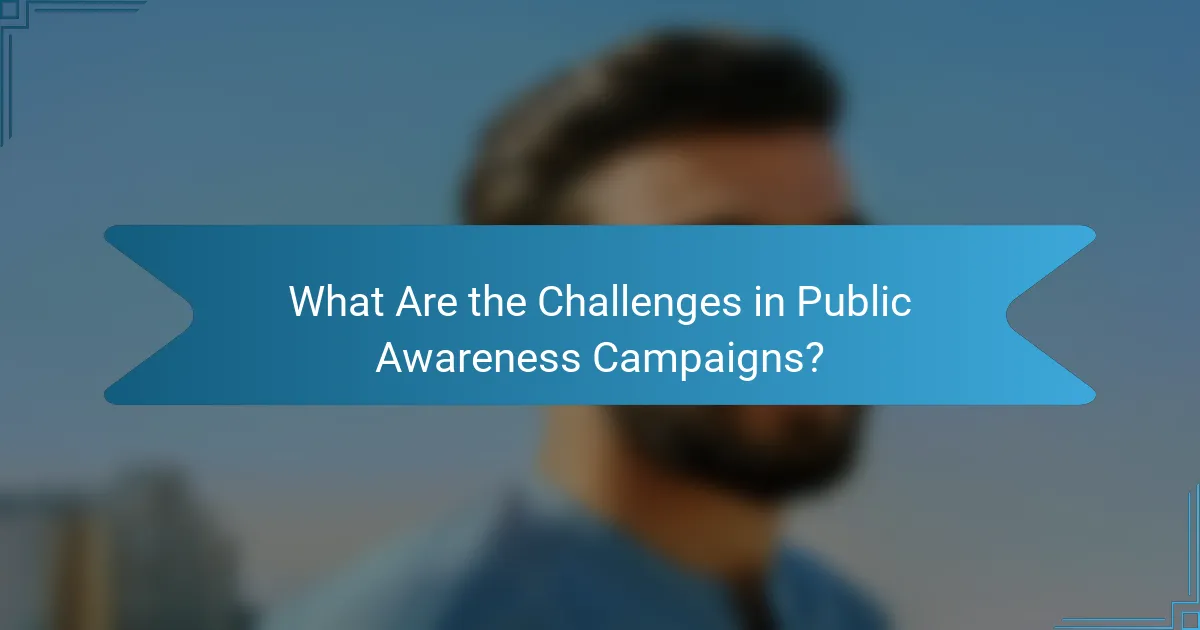
What Are the Challenges in Public Awareness Campaigns?
Public awareness campaigns face several challenges that can hinder their effectiveness. Key issues include ensuring message clarity, engaging the target audience, and allocating resources efficiently.
Message Clarity
Message clarity is crucial for the success of public awareness campaigns. A clear and concise message ensures that the audience understands the campaign’s purpose and desired actions. Ambiguity can lead to confusion and disengagement.
To enhance clarity, use straightforward language and avoid jargon. For instance, instead of saying “utilize,” simply say “use.” Testing messages with a small audience can help identify any unclear elements before full deployment.
Audience Engagement
Engaging the audience is vital for capturing attention and fostering participation. Campaigns should employ interactive elements, such as social media polls or community events, to encourage involvement and feedback.
Consider tailoring content to the specific interests and needs of the target demographic. For example, using local influencers or relatable stories can significantly boost engagement levels and make the campaign more relatable.
Resource Allocation
Efficient resource allocation is essential for maximizing the impact of public awareness campaigns. This includes budgeting for advertising, materials, and personnel. Misallocation can lead to wasted efforts and reduced effectiveness.
Establish a clear budget and prioritize spending based on the most effective channels for reaching your audience. Regularly review the campaign’s performance to adjust resource distribution as needed, ensuring that funds are directed towards the most impactful strategies.

What Are Some Successful Case Studies in the UK?
Successful case studies in the UK demonstrate effective public awareness strategies that leverage both online and offline approaches. These initiatives often combine community engagement, digital campaigns, and educational programs to achieve significant impact.
Case Study: The “Change4Life” Campaign
The “Change4Life” campaign is a prominent example of a public health initiative aimed at promoting healthier lifestyles among families in the UK. Launched by Public Health England, it utilizes a mix of television advertisements, social media engagement, and community events to raise awareness about healthy eating and physical activity.
Key elements of the campaign include interactive online resources, such as meal planners and activity trackers, which encourage participation. The campaign has successfully reached millions of families, significantly increasing awareness of healthy habits.
Case Study: The “This Girl Can” Movement
By focusing on inclusivity and body positivity, the campaign has inspired many women to participate in sports and exercise. The movement has been effective in increasing female participation in physical activities, showcasing the power of relatable messaging.
Case Study: The “Keep Britain Tidy” Initiative
The “Keep Britain Tidy” initiative focuses on environmental awareness and community clean-up efforts. This campaign employs a combination of local events, educational workshops, and social media outreach to promote litter reduction and environmental stewardship.
Through partnerships with local councils and community groups, the initiative has mobilized thousands of volunteers. It emphasizes the importance of community involvement in maintaining clean public spaces, demonstrating how local action can lead to national change.
